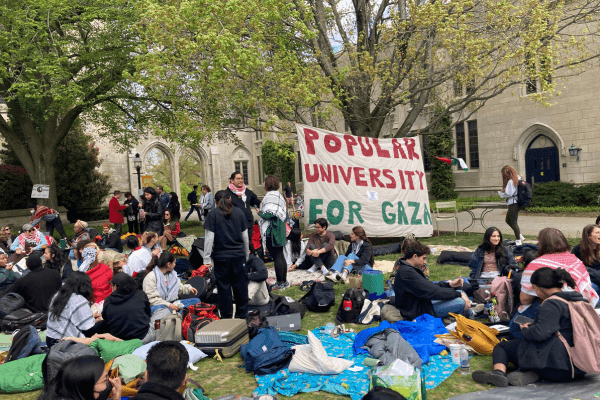In the last few weeks of August 2019, women in Mexico City joined the 'revolución diamantina’ (glitter revolution), expressing their anger over institutionalized violence against women. Armed with pink glitter, the protesters rallied in the streets, chanting,“They don’t protect us, they rape us.”
“Feminism has been around [for] over 20 years in the country, but we had never been able to hold the spotlight on an issue like how the young people in the country did this time with the glitter protest,” said Tania Reneaum, Executive Director of Amnesty International Mexico.
The protests began after allegations surfaced that four police officers in Mexico City had raped a 17-year-old girl in their patrol car as she left a party in the municipality of Azcapotzalco. Six days after this incident, a 16-year-old girl said that a policeman raped her at the Photographic Archive located in the center of the city.
“In Mexico, the relationship between women and the police is a broken one,” Reneaum explained. “The police should be ensuring the safety of women, but they are the ones that are violating women’s rights.”
In 2016, Amnesty International interviewed 100 women in Mexico’s prisons. The interviews revealed that women were routinely abused by security forces to coerce confessions that paint the police as effective in tackling organized crime. The Amnesty report states that “Seventy-two [incarcerated women] said they were sexually abused during their arrest or in the hours that followed. Thirty-three reported being raped.” Erika Guevara-Rosas, Americas Director at Amnesty Internationalsaid that sexual violence, used as a form of torture "seems to have become a routine part of interrogations.”
In the first half of 2019, complaints were filed in Mexico for 448 femicides, 1,364 malicious homicides against women, 206 kidnappings, and more than 30,000 malicious injuries against women. According to the United Nations, Mexico is the second-most dangerous country for women in Latin America, after Brazil.
Advocates also scrutinize the manner in which officials handle cases where women allege that they have been victims of violence. Elidet García, a volunteer for the local Amnesty group in Michoacán, explained that in the case of the girl who was raped by four policemen, the victim was questioned publicly by police authorities who also said that she was lying. “These kind of first responses were not good enough for many feminist groups,” said García.
She further explained that when the head of the police force in Mexico was giving an interview, a girl threw glitter at his face and this video went viral. After this, a mobilization was called in Mexico City and these mobilizations were replicated in many places across Mexico. Overall, protests took place in about half of the 32 states in Mexico, Garcia said.
García attended the protests that took place in Michoacán where protesters brought to light a case where a female journalist went to the police force to put an end to sexual aggression that she was facing from a policeman. But during the process, the journalist was blamed and “made to feel like a victim again," García explained. “There is a connection in all these cases which make it clear that the problem is [systemic].”
Many residents of Mexico looked negatively on the officials’ reactions to the glitter protest.
Last year, Claudia Sheinbaum Pardo became the first woman to be elected as mayor of Mexico City. In her first few statements after the protest, she said that she would take action against women who were responsible for spray painting the base of the Angel of Independence monument and the streets as signs of protest. She also held the protesters responsible for provoking the authorities into using force.
“This was a very negative thing to say because the police, under her command, raped women and she did not mention this,” Reneaum said.
“A woman senator [Miriam Ferraez Centeno] said that there is a time at night after which women should stay at home,” explained Liliana Cruz, a feminist activist in Mexico. “Women came out on the streets to protest because ideas like this are silly.”
Reneaum believes that the behavior of the police toward women is reflective of broader societal attitudes of “misogyny and machismo.”
“The police engage in a kind of informal social control,” Reneaum said. She noted that the police would ask victims what they were doing out on the streets at 2 a.m., often making judgmental comments like, ‘She was probably out with her boyfriend and drinking.’
When women break free from such societal control, “we are suddenly responsible for our misfortunes,” Reneaum explained.
As of October, the police have launched investigations into the cases where the officers allegedly raped the teenage girls. But activistsare skeptical of the outcome of these investigations.
“There is no accountability because the same police force [comprising of men who raped the teenage girls] is looking into the cases,” Reneaum said. “The people investigating those who are accused are probably their friends and colleagues.”
Garcia said that the feminist movement in Mexico is still continuing today to stop violence against women and promote access to safe abortions. On September 28, many activists across Mexico took to the streets to demand legalization of abortion throughout the country.
As of today, abortion is only allowed in certain regions of the country like Mexico City.
According to Cruz,the same women who took part in the glitter protests — joined by other groups — came out in September to demand greater reproductive rights. “This is again a form of gender violence because someone else wants to control our bodies,” she said.
For Mexico, there’s a long way to go in pushing for state-action on crimes against women. As Garcia said, “The state is in debt to the women because of the violence we suffer.”
Got something to say about what you're reading? We value your feedback!







